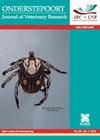ASF -survivors’ Sera Do Not Inhibit African Swine Fever Virus Replication in Vitro
IF 1.6
3区 农林科学
Q2 VETERINARY SCIENCES
引用次数: 1
Abstract
Abstract Introduction African swine fever virus (ASFV) causes one of the most dangerous diseases of pigs and wild boar – African swine fever (ASF). Since its second introduction into Europe (in 2007), the disease has been spreading consistently, and now ASF-free European countries are at risk. Complex interactions between the host’s immune system and the virus have long prevented the development of a safe vaccine against ASF. This study analysed the possibility of neutralisation of the ASFV in vitro by sera collected from ASF-survivor animals. Material and Methods Two pig and three wild boar serum samples were collected from previously selected potential ASF survivors. All sera presented high antibody titres (>5 log10/mL). Primary alveolar macrophages were cultured in growth medium containing 10% and 20% concentrations of selected sera and infected with a haemadsorbing ASFV strain (Pol18_28298_O111, genotype II). The progress of infection was investigated under a light microscope by observing the cytopathic effect (CPE) and the haemadsorption phenomenon. Growth kinetics were investigated using a real-time PCR assay. Results Haemadsorption inhibition was detected in the presence of almost all selected sera; however, the inhibition of virus replication in vitro was excluded. In all samples, a CPE and decreasing quantification cycle values of the viral DNA were found. Conclusion Anti-ASFV antibodies alone are not able to inhibit virus replication. Interactions between the humoral and cellular immune response which effectively combat the disease are implicated in an ASF-survivor’s organism.非洲猪瘟幸存者血清体外不抑制非洲猪瘟病毒复制
摘要非洲猪瘟病毒(African swine fever virus, ASFV)引起猪和野猪最危险的疾病之一-非洲猪瘟(African swine fever, ASF)。自第二次传入欧洲(2007年)以来,该疾病一直在持续传播,现在无非洲猪瘟的欧洲国家处于危险之中。长期以来,宿主免疫系统与病毒之间复杂的相互作用阻碍了针对非洲猪瘟的安全疫苗的开发。本研究分析了从非洲猪瘟存活动物收集的血清在体外中和非洲猪瘟病毒的可能性。材料与方法从先前选择的可能的非洲猪瘟幸存者中采集2份猪血清和3份野猪血清。所有血清抗体滴度均较高(>5 log10/mL)。将原代肺泡巨噬细胞置于含10%和20%血清浓度的生长培养基中,感染一株吸附血液的ASFV (Pol18_28298_O111,基因型II),在光镜下观察细胞病变效应(CPE)和血液吸附现象,观察感染进展。采用实时PCR法研究其生长动力学。结果几乎在所选血清中均检测到血液吸附抑制;然而,排除了病毒在体外复制的抑制作用。在所有样本中,发现病毒DNA的CPE和减少的定量周期值。结论单抗asfv抗体不能抑制病毒复制。有效对抗疾病的体液免疫反应和细胞免疫反应之间的相互作用与非洲猪瘟幸存者的机体有关。
本文章由计算机程序翻译,如有差异,请以英文原文为准。
求助全文
约1分钟内获得全文
求助全文
来源期刊
CiteScore
4.30
自引率
0.00%
发文量
13
审稿时长
16 weeks
期刊介绍:
The Onderstepoort Journal of Veterinary Research, is the official publication of the Onderstepoort Veterinary Institute. While it considers submissions from any geographic region, its focus is on Africa and the infectious and parasitic diseases and disease vectors that affect livestock and wildlife on the continent.

 求助内容:
求助内容: 应助结果提醒方式:
应助结果提醒方式:


